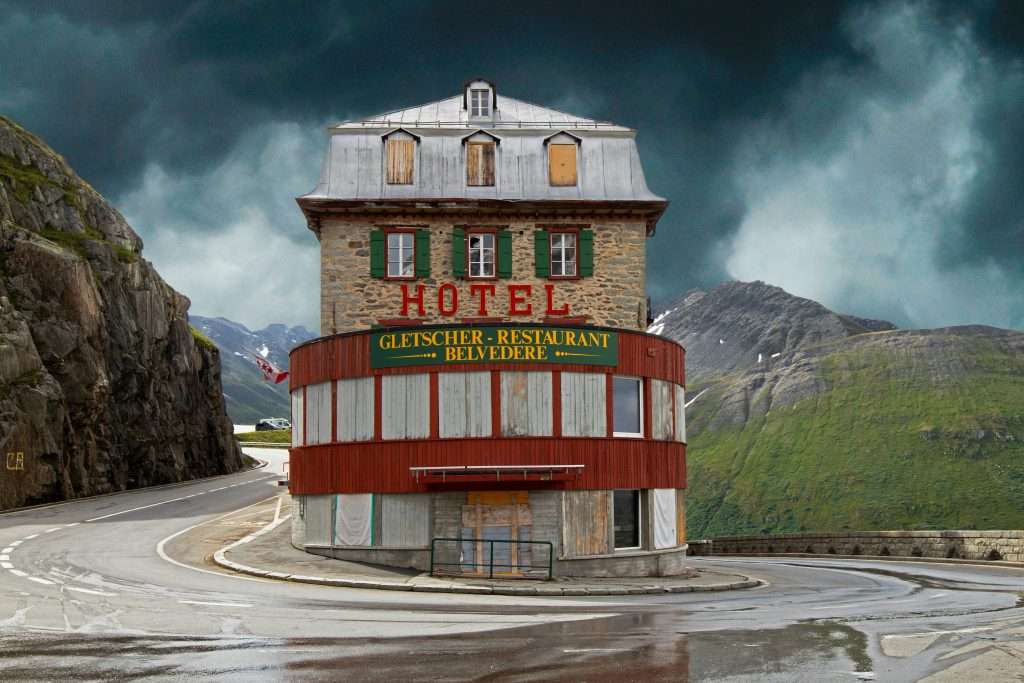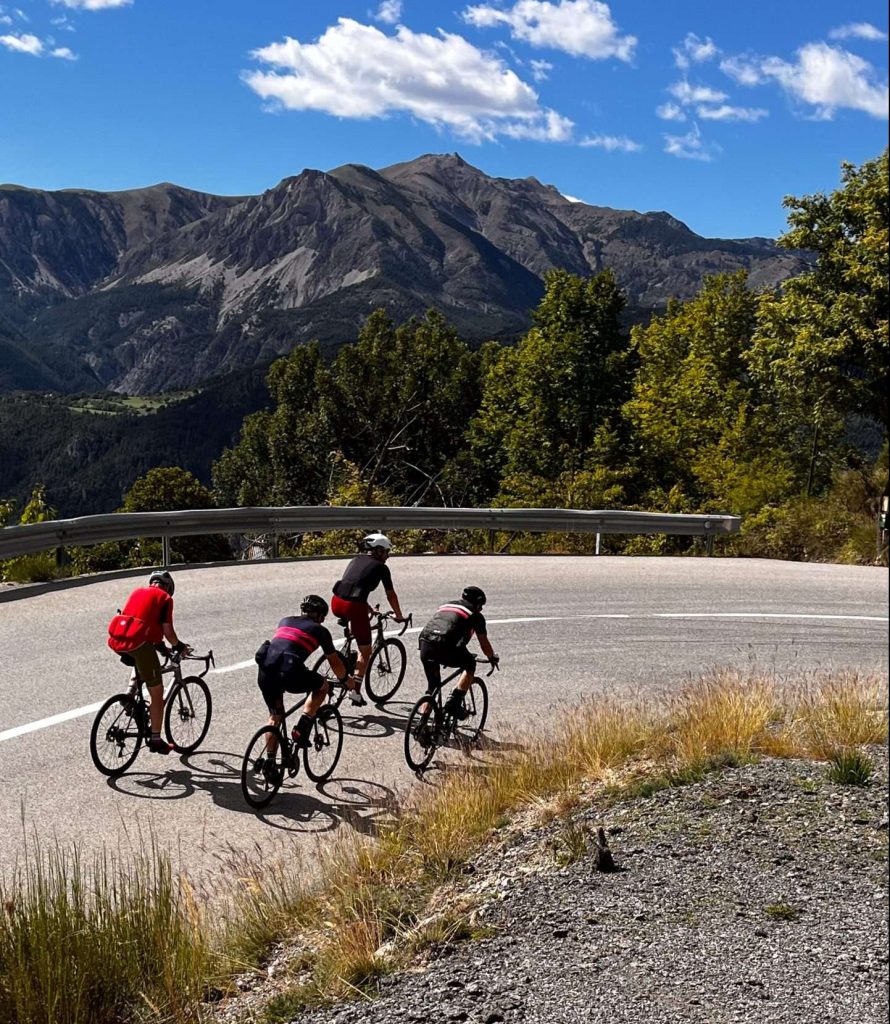
Cycling through the Alps is a transformative experience, however learning how to master the Alps is another thing, especially if you live in the UK. This guide will help prepare you for an Alpine cycling holiday, covering upcoming trips, training advice, and gear tips.
Key Takeaways
| Aspect | Key Points |
| Training |
|
| Pacing |
|
| Power Management |
|
| Power-to-Weight Ratio |
|
| Gearing and Cadence |
|
| Environmental Factors |
|
Upcoming Alpine Cycling Camps
The Swiss Alps
When: June 2025 – Dates to be confirmed
What to expect: * Note exact routes are still being finalised
5 days of riding
400 km of terrain
10 km of climbing
Legendary passes:
- Grosse Scheidegg (1270 m) 16.1 km
- Furka Pass (891 m) 12.2 km
- Gotthard Pass (672 m) 11.2 km (Cobbled masterpiece)
The Dolomites
When: September 2025 – Dates to be confirmed
What to expect: * Note exact routes are still being finalised
7 days of challenging rides
365 km of scenic routes
About 10 km of climbing
Iconic climbs:
- Sella Campigotto & Passo Tre Croci
- Passo Giau, Passo Falzarego & Valparola & Mur di Giat
- Passo Campolongo, Pordoi, Sella & Gardena
- Passo Stelvio
- Passo Mortirolo & Gavia
How to Master the Alps: Expert Advice

Training at Home: Making the Most of What You’ve Got
Even if you’re not near mountains, you can still prepare for long Alpine climbs; you just have to be a little creative:
Hill reps: Quality over quantity
- Find the longest climbs nearby, even if they’re only 5-10 minutes.
- Do multiple reps, keeping a steady pace.
- Gradually increase reps to build stamina.
- Try 8-10 reps of a 5-minute climb, with 2-3 minutes rest between each.
Mental training: Building grit
- Visualize longer Alpine climbs during hill reps.
- Use positive self-talk and mantras for tough moments.
- Set mini goals on longer rides to mimic multi-hour climbs.
Improve climbing technique: Efficiency is key
- Keep a smooth pedal stroke throughout.
- Practice seated and standing climbing to engage different muscles.
- Work on upper body position for better aerodynamics and breathing.
- Check out our post ‘How to ride up hills faster on your bike’
- Also check out GCN’s video – https://www.youtube.com/watch?v=Cp5uuxT1V1Q – GCN 5 Easy Tips to Ride Long Climbs Faster.
Boost Functional Threshold Power (FTP): The foundation of climbing
- Do structured intervals to increase sustainable power.
- Regular FTP tests (20-minute all-out efforts) to track progress.
- Gradually increase threshold interval duration to mirror longer climbs.
- If you need some help in planning your off season training, then check out our post ‘Cycling Training Plan | How to Plan Off Season Training’
Changing Your Mindset for Mountain Riding: Patience Pays Off
Success in the mountains requires a different approach compared to flat riding, in the UK or other relatively flat countries, because the climbs are relatively short, your approach is typically at pace if not full gas. That doesn’t work in the Alps. It is common to see many riders on the first climb of the first day, set off at very fast pace. Then 20 minutes later you can see they’re struggling. It is because they haven’t paced it. This continues and, come the third day, they’re done and starting to think this isn’t fun anymore:
Pacing is crucial: Slow and steady wins the race
- Start climbs easy, aiming to maintain a steady effort.
- Use a power meter or heart rate monitor to avoid going too hard early on.
- Try “negative splitting” on longer climbs, finishing stronger than you started.
Focus on endurance: Embrace the long haul
- Do longer rides (4-6 hours) in training, even on flatter ground.
- Practice proper nutrition and hydration during these long rides.
- Mentally prepare for Alpine climbs that can last hours.
Pretend you’re riding into a headwind: Resistance training on the flat
- On flat ground, intentionally ride into the wind or use a harder gear.
- Maintain this for 30-60 minutes to mimic a long climb.
- Focus on keeping a steady cadence and power despite the extra effort.
Managing Power: Tools and Techniques
Managing your power output is key for mountain success. Here’s how to use various tools:
Power meter: Precise pacing
- Keep power in Zone 3 (76-90% of FTP) for most long climbs.
- Allow short bursts into Zone 4 (91-105% of FTP) for steeper sections or attacks.
- Use your power meter to avoid pushing too hard early in multi-day tours.
Heart rate monitor: Cardiovascular insight
- Aim for 84-94% of your lactate threshold heart rate for sustained climbing.
- Remember that heat and altitude can affect heart rate.
- Use heart rate alongside perceived effort for a fuller picture.
Perceived effort: The ultimate backup
- Familiarize yourself with the Borg scale (6-20) for rating perceived effort.
- Aim for levels 13-15 (somewhat hard to hard) during most climbs.
- Trust your feelings, especially when other metrics might be unreliable.
Optimizing Power-to-Weight Ratio: The Climber’s Holy Grail

Coach Phil Mosley explains the crucial power-to-weight ratio that can significantly impact your Alpine performance and help master the Alps:
Increase power output: Structured progression
- Follow a periodized training plan with varied intensities.
- Engage in specific climbing intervals: 8-20 minute efforts at threshold power.
- Gradually increase training volume and intensity as you approach the event.
Reduce weight: Sustainable strategies
- Lose excess body fat through dietary changes and increased training.
- Aim to lose 0.5-1 kg per week while maintaining muscle and energy levels.
- Consider lighter gear but prioritize reliability and comfort for multi-day events.
To help you understand the impact of power-to-weight ratio on your climbing speed, check out the simple calculator at the bottom of this post. This calculator gives a rough estimate of climbing speed based on power, weight, and gradient. It’s a simplified model, but it shows how changes in power or weight can affect your speed on climbs.
Gearing and Cadence: Finding Your Rhythm
The right gears and cadence can make the difference between mastering a climb and walking:
Lower gears are better: Prepare for the worst
- Consider swapping to an easier cassette (e.g., 11-34 or even 11-36) for very steep gradients
- A compact crankset (50/34 or 52/36) with a wide-range cassette gives options for varied terrain
- Remember, it’s better to have gears you don’t need than to need gears you don’t have
Work on cadence: Efficiency in motion
- Practice keeping a higher cadence (85-95 rpm) on climbs to reduce muscle fatigue
- Do specific high-cadence intervals in training to improve neuromuscular efficiency
- Try different cadences during training to find your most efficient climbing rhythm
Environmental Considerations: Adapting to Alpine Conditions
The Alps present unique challenges that need specific prep:
Altitude: Breathing easier
- While specific altitude training might not be practical, overall fitness helps mitigate the effects
- Arrive at the event location a few days early if possible, to begin acclimatising
- Stay well-hydrated and be prepared to pace yourself more conservatively at higher altitudes
Heat adaptation: Beating the Alpine sun
- Do post-workout heat exposure (15-30 minutes in a hot bath or sauna) to improve heat tolerance
- Practice riding during the hottest part of the day in the weeks before your event
- Develop and practice your hydration and cooling strategies (e.g., ice socks, proper clothing choices)
Layering: Be prepared for all conditions
- Pack versatile clothing to handle temperature changes, which can be extreme in the mountains
- Invest in good, lightweight arm and leg warmers, a packable rain jacket, and a gilet for descents
- Practice your layering strategy during training rides to find the right balance of comfort and performance
The Payoff: Reaping the Rewards
Arriving well-prepared for these Alpine adventures will transform your experience from a gruelling challenge into an exhilarating journey. Good training, smart pacing, and thoughtful gear choices will help you conquer challenging cols and create lasting memories.
As you climb higher and push your limits, you’ll gain a new appreciation for the raw beauty of the Alps and what your body can do. The sense of achievement as you crest each summit, the bonds forged with fellow riders, and the personal growth from overcoming such a big challenge are rewards that go beyond just cycling.
Remember, at the end of the day, it’s all about having fun. Whilst prepping for Alpine adventures takes serious dedication, don’t forget the joy and passion that got you into cycling in the first place.
So, are you ready to test your limits and experience the thrill of cycling in the Alps? With solid preparation and the right mindset, you’re set to achieve something truly extraordinary on two wheels. The mountains are calling – time to answer and create your own epic Alpine cycling story, check out our road cycling holidays here, Port Velo.
Frequently Asked Questions (FAQ)
- Q: How long should I train for an Alpine cycling event? A: Ideally, start specific training at least 3-4 months before the event. This gives you time to build endurance, improve climbing skills, and adapt to longer rides.
- Q: What’s the best way to simulate Alpine climbs if I live in a flat area? A: Use a combination of tactics: – Do multiple repetitions on the longest hills you can find – Use a higher gear on flat roads to increase resistance – Incorporate indoor training with climbing-specific workouts
- Q: How important is weight loss for Alpine cycling? A: While power-to-weight ratio is crucial for climbing, focus first on building power and endurance. Any weight loss should be gradual and healthy, not compromising your training or overall health.
- Q: What gearing do I need for Alpine climbs? A: Most riders benefit from a compact crankset (50/34 or 52/36) and a wide-range cassette (e.g., 11-32 or 11-34). This provides low gears for steep sections while maintaining range for varied terrain.
- Q: How do I deal with altitude sickness? A: Arrive a few days early if possible, to acclimatise. Stay well-hydrated, avoid alcohol, and be prepared to pace yourself more conservatively. If symptoms persist, descend to a lower altitude.
- Q: What’s the most important thing to remember during an Alpine cycling event? A: Pace yourself. It’s easy to get caught up in the excitement and go too hard early on. Consistent, steady effort will serve you better over multiple days of challenging climbs.
- Q: How do I prepare for rapidly changing weather in the Alps? A: Pack versatile, layerable clothing. Always carry a lightweight waterproof jacket and arm warmers, even on sunny days. Check weather forecasts regularly and be prepared to adjust your plans if necessary.
- Q: Can I use a standard road bike for Alpine cycling, or do I need a specific climbing bike? A: A standard road bike is fine for most riders. The most important factors are having appropriate gearing and ensuring your bike fit is comfortable for long climbs.
- Q: How much should I eat and drink during Alpine climbs? A: Aim to consume 30-60 grams of carbohydrates per hour during rides. Drink regularly, about 500-750 ml per hour, adjusting for heat and intensity. Practice your nutrition strategy during training.
- Q: What if I can’t complete a climb? Are there support vehicles? A: Most organised events have support vehicles but check the specific event details. It’s always wise to carry a phone, some cash, and basic tools for emergencies. Remember, there’s no shame in walking if you need to – many famous pros have done so on the toughest climbs!
Advanced Cycling Power-to-Weight Calculator
Estimated Time to Complete the Climb: 00:00:00

Leave a Reply